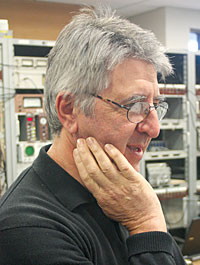George Dionisios Dracoulis
DOI: 10.1063/PT.3.2592
Nuclear physicist George Dionisios Dracoulis had a vibrant and charismatic personality. As a meticulous researcher, he was known for the reliability of his results—if George had measured it, then you knew it was right. And he took his wit and wisdom outside the laboratory when he served as a respected science adviser to the Australian government. He passed away at home in Canberra, Australia, on 19 June 2014 after a short battle with cancer.

George Dionisios Dracoulis

Born in Melbourne, Australia, on 19 December 1944, George pursued his undergraduate and postgraduate studies at the University of Melbourne, from which he received a PhD in nuclear physics in 1970. After a three-year postdoctoral research position at the University of Manchester in the UK, he returned to Australia to take a research position at the Australian National University in Canberra, where the world’s largest tandem Van de Graaff heavy-ion accelerator was under construction. George played an integral, and soon leading, role in the accelerator’s development and exploitation as a research facility. As head of the university’s department of nuclear physics from 1992 until his retirement in 2009, he established it as one of the most respected nuclear-physics laboratories in the world.
In retirement, George continued as an indefatigable researcher. He traveled the world to perform experiments and speak at conferences until diagnosed with kidney cancer in March of this year. In addition to having a network of friends and colleagues around the globe, George enjoyed extended visits to Stony Brook University in New York, Argonne National Laboratory in Illinois, Lawrence Berkeley National Laboratory in California, and the University of Surrey in the UK.
George made seminal contributions to the understanding of nuclear structure: the way different nuclear shapes can coexist; the way nuclear vibrations, especially octupole vibrations, can couple to neutron and proton excitations; and the way metastable excited states, or isomers, can be used to probe nuclear spin and shape properties. He was renowned for the thoroughness of his experimental approach, which he combined with a deep physical understanding of nuclear phenomena.
Among the numerous awards George received were the Australian Academy of Science’s 2003 Thomas Ranken Lyle Medal for outstanding contributions to our understanding of the structure of atomic nuclei and the Australian Institute of Physics’ 2004 Walter Boas Medal for excellence in physics research.
George served as a member of the Australian Prime Minister’s Select Task Force on Uranium Mining, Processing and Nuclear Energy in 2006. As professor emeritus, he remained active in public education and continued to engage with the media and in the public discussion of nuclear energy and nuclear technology. George also continued his nuclear-physics research work until only a few weeks before he died.
George will be greatly missed by his family, friends, and colleagues around the world.
More about the Authors
Philip Walker. University of Surrey, Guildford, UK.
Andrew Stuchbery. Australian National University, Canberra.
Filip Kondev. Argonne National Laboratory, Argonne, Illinois.
